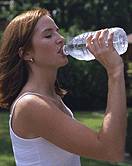- Navigating Your Midlife Crisis: Embracing New Possibilities
- City Raccoons Showing Signs of Domestication
- Mapping the Exposome: Science Broadens Focus to Environmental Disease Triggers
- One Week Less on Social Media Linked to Better Mental Health
- Your Brain Changes in Stages as You Age, Study Finds
- Some Suicide Victims Show No Typical Warning Signs, Study Finds
- ByHeart Formula Faces Lawsuits After Babies Sickened With Botulism
- Switch to Vegan Diet Could Cut Your Greenhouse Gas Emissions in Half
- Regular Bedtime Does Wonders for Blood Pressure
- Dining Alone Could Mean Worse Nutrition for Seniors
Endurance Athletes Should Only Drink When Thirsty, Experts Say


Endurance athletes or those who are very physically active should drink plenty of water — but only when they feel thirsty, new expert recommendations say.
Athletes should listen to their body and drink water as needed to prevent a potentially deadly condition called exercise-associated hyponatremia (EAH) or “water intoxication.” The new guidelines were developed at the International Exercise-Associated Hyponatremia Consensus Development Conference in Carlsbad, Calif., and published June 29 in the Clinical Journal of Sport Medicine.
Overdrinking, particularly when exercising or playing sports in the heat, can increase the risk of seriously low levels of sodium in the blood. Excessive intake of water, sports drinks or other fluids can exceed the body’s ability to get rid of fluids in sweat or urine. When the body can’t remove excess fluids, those fluids dilute the body’s sodium level, which can drop during exercise or up to 24 hours later.
Symptoms may appear mild at first, but progressively worsen. Warning signs of water intoxication include headache, vomiting, confusion and seizures.
These symptoms develop as the brain swells. Without treatment, water intoxication can quickly become deadly.
If people “drink when thirsty,” however, they can avoid this dangerous drop in blood sodium levels, according to the recommendations.
“The safest individualized hydration strategy before, during and immediately following exercise is to drink palatable fluids when thirsty,” the statement said.
The development of the new guidelines was prompted by the deaths of two high school football players from exercise-associated hyponatremia last summer, the researchers said.
“The release of these recommendations is particularly timely, just before sports training camps and marathon training begins within the United States — where the majority of EAH deaths have occurred,” said the report’s lead author, Dr. Tamara Hew-Butler, associate professor of exercise science at Oakland University in Rochester, Mich. “Our major goal was to re-educate the public on the hazards of drinking beyond thirst during exercise,” she said in a journal news release.
Athletes and coaches must also be aware of the risks associated with “forced hydration” practices. “Every single EAH death is tragic and preventable, if we just listen to our bodies and let go of the pervasive advice that if a little is good, more must be better,” Hew-Butler said.
The report also advised doctors that hyponatremia treatment should be based on the severity of patients’ symptoms — not just their sodium levels.
More information
The U.S. National Library of Medicine provides more information on water intoxication, or hyponatremia.
Source: HealthDay
Copyright © 2025 HealthDay. All rights reserved.










